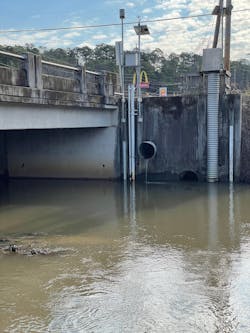Stormwater management plays a critical role in the operations of any public works department. Regulating stormwater runoff requires effective strategies to reduce flooding, protect the environment, protect infrastructure and support the health of the community.
State regulators conduct audits to ensure proper guidelines and procedures are followed to meet stormwater permit requirements. Self-audits, administered to address a municipality’s stormwater management program internally, have become a proven approach for municipalities to become or remain compliant and gives them the opportunity to advance their programs prior to state audits.
“I would recommend any community go through a self-audit,” said Kannapolis, N.C., Assistant City Manager Wilmer Melton, whose municipality recently conducted a successful self-audit with Woolpert. “It really gives you a good sense of where the program stands, identifying potential areas of weakness before getting put on the spot by the state.”
NPDES and State Audits
Created in 1972 by the Clean Water Act, the National Pollutant Discharge Elimination System (NPDES) program helps address water pollution by regulating point sources that discharge pollutants to waters of the United States. The NPDES stormwater program regulates stormwater discharges from three potential sources: municipal separate storm sewer systems (MS4s), construction activities and industrial activities.
The U.S. Environmental Protection Agency (EPA) uses a variety of methods to determine whether regulated entities are complying with NPDES permit requirements, varying from state to state and per facility type. These methods include inspecting facilities, reviewing records and reports, and responding to citizen complaints. If an entity is violating its permit, the EPA (or the state, if the program is delegated) may file an enforcement action and seek penalties of up to $27,500 per violation, per day.
The penalty depends on many factors, including the number, length and severity of the violations; the economic benefit obtained by the violator; and its ability to pay. Policies are in place to ensure penalties are calculated fairly, and these policies are available to the public. Any company charged with a violation can contest the EPA’s allegations and the proposed penalty before an impartial judge or jury.
Due to the volume of stormwater programs, state regulatory authorities sometimes have difficulty supervising every program under their jurisdiction. Over the last decade, the North Carolina Department of Environmental Quality (NCDEQ) has identified several programs with compliance inconsistencies. This incurred more frequent audits in which MS4s were unprepared and faced with potential penalties. In response, North Carolina is on its way to requiring self-audits every year, an initiative that likely would benefit all states.
Self-Audits Enter the Stream
Each municipality assumes the responsibility for its stormwater program. This includes updating the program, consistently monitoring stormwater runoff and recording the appropriate information for reporting. Communities that do not maintain their stormwater programs tend to generate greater EPA and state scrutiny, which garners negative publicity for their programs and their leadership. However, self-assessments can be used to recognize and address program deficiencies before state regulators become involved.
It is recommended that a municipality conduct a self-audit annually. As noted, North Carolina is considering making annual self-audits a requirement. But currently, the timeline is at the discretion of the MS4. The first self-audit completed by a municipality should be thorough and review all aspects of its NPDES permit. The self-audit process can be streamlined in successive years as the program progresses.
Self-audits can be conducted by the permit holder, a third party or by another MS4. Spartanburg County Public Works Stormwater Manager Timothy Sherbert said an outside perspective often identifies issues that departments can miss.
“When everything in our program appears to be running smoothly, it can be easy to forget about the small things,” Sherbert said. “The self-audits pick up the small compliance tasks that are often overlooked and give us a chance to correct them before the official audit.”
In preparation for a state audit, the auditor will request and review documents before scheduling an in-person audit meeting. A state audit is typically comprised of an office portion lasting one to three days, where interviews and program processes and procedures are reviewed. In addition, one to two days are usually scheduled for field inspections at municipal facilities, structural controls and construction sites.
Upon completion, auditors compile a full report, and the MS4 is required to respond with a plan for addressing noted deficiencies. This process typically occurs once during a permit term, so communities need to plan for when to conduct a self-audit to ensure they are prepared to take the necessary steps.
“The Woolpert team played the role of a state auditor by asking tough questions to staff members so that they would understand how to answer questions in a tense situation,” said Melton, relating his self-audit experience. “It was really good to be able to then go back and strengthen different parts of our program in preparation for the state audit. We could understand the difficult questions and feel comfortable in the real situation.”
A detailed self-audit not only describes program deficiencies and recommends how to correct those issues but also highlights the level of deficiency or compliance of each component. Recommendations can range from compliance-related tasks to best practice and benchmark program recommendations. This provides insight into how clients can continue to improve their stormwater programs, no matter what status their program currently holds, to eventually have a premier stormwater program that benefits the community and the MS4.
By reporting a stormwater program’s compliance level, municipalities can decide to redirect resources toward a lesser area, continue funding the compliant area at the same level or invest in bringing a program component to benchmark status. Leaders also can leverage the increasing quality of their programs. Self-audits also bring communities to a place of preparedness with their stormwater programs.
“What the self-audit helped us do was streamline our reporting more than anything else,” said Kevin Blayton, city engineer and public works director for North Myrtle Beach, S.C. “It gave us a better feel for when we needed to wrap up our activities so that we could get them into an annual report.”
Richland County, S.C., Stormwater Manager Synithia Williams said she realized an additional payoff through conducting a self-audit.
“It helped me better explain to the other department areas what they need to do to stay in compliance — without simply giving orders,” Williams said. “It provided an outside look at our program and told us things that we could be doing to better improve our construction inspection process.”
Frequency and Growth of Self-Audits
Knowing what is expected and how to meet expectations is imperative to success. Self-audits enable MS4s to realize unknown deficiencies, providing the opportunity to further develop monitoring and reporting programs, identify better management procedures, determine accountability and coordinate program work between departments.
By evaluating stormwater programs before a state audit, municipalities ensure they meet the state's requirements and expectations, avoiding fines and penalties, while protecting their communities to the letter of the law. SW
Woolpert Project Manager and Senior Associate Trevor Gauron, PE, and Phase Manager Rebecca Coulter, PE, both work out of the firm’s Columbia, S.C., office.
Published in Stormwater magazine, May 2021
About the Author

Trevor Gauron
Trevor Gauron, PE, is a Project Manager and Senior Associate with Woolpert. He works out of the firm’s Columbia, S.C., office.

Rebecca Coulter
Rebecca Coulter, PE, is a Phase Manager with Woolpert. She works out of the firm’s Columbia, S.C., office.



